L’atelier de photo: Un circuit dans Côte-des-Neiges avec Baobab Familial
Submitted by Maude Blanchet-Léger on
par / by Maude Blanchet Léger
Le mercredi 5 août, j’ai été invitée à me joindre à un atelier de photo dans le quartier Côte-des-Neiges avec Ducakis et Thierry, deux de nos médiateurs. Le projet a été initié par Ducakis il y a un an et à pour but de faire découvrir la photo aux participant.es et de leur permettre de se (ré)approprier leur quartier à travers ce médium artistique.
La photographie est l’un des médiums que je préfère. Je fais beaucoup de photo depuis l’âge de 15 ans et j’ai développé ma pratique durant mon bac en arts visuels, alors j’étais vraiment excitée de pouvoir partager l’une de mes passions avec des jeunes.
Baobab familial est un organisme qui favorise l'entraide, l'échange et le sentiment d'appartenance à son milieu en accueillant et en soutenant les familles dans leur quotidien. J’apprends aussi que le public sera ado, mais nous ne savons pas combien participeront aujourd’hui. Ne sachant pas non plus le niveau de connaissance des jeunes sur la photographie, je leur ai préparé une feuille aide-mémoire démontrant quelques exemples de compositions, de cadrages et d’angles de vue.
Avant de partir avec la mobile, j’imprime quatre copies de l’aide-mémoire, parce que nous apprenons finalement qu’ils seront probablement quatre à participer. Nous regroupons cinq caméras, s'assurons qu’elles ont toutes des cartes mémoires et des batteries pleines, et hop, on les désinfecte dans la van sur le chemin, direction parc Martin Luther-King.
Au parc, on trouve les intervenantes de Baobab, Anne-Marie et Andréanne, à une table à picnic et on se présente. Elles nous disent qu’ils seront finalement plus nombreux, que plusieurs arriveront plus tard, et on se dit qu’ils pourront se mettre en équipe de deux ou utiliser leur cellulaire au besoin pour prendre des photos.
Une fois quatre des jeunes arrivés, Ducakis leur explique l’atelier. L’un d’entres eux, Marc*, se tient plus à l’écart et Thierry lui parle, afin de l’inclure et de tenter de le faire s’approcher. On se couvre en dessous d’un toit puisqu’il se met à pleuvoir très fort et après mon cours express sur les compositions, la pluie s’arrête. On distribue alors les caméras et on passe quelques minutes à voir les fonctionnements techniques des appareils, comme ils sont tous différents. Je leur fais savoir aussi qu’en photo, il ne faut pas avoir peur de bouger, de se déplacer, de pointer son objectif en haut, en bas, de côté, etc. La photo, c’est du sport!
Avant de débuter le trajet, nous demandons aux jeunes ce qu’ils voudraient prendre en photo, où ce qu’ils aiment et n’aiment pas dans leur quartier et de nommer des endroits de leur quotidien par exemple, afin de déterminer quel trajet nous allons emprunter. Marc parle du centre sportif et du dépanneur au coin de sa rue, une jeune mentionne la bibliothèque et le parc, une autre le Tim Hortons et Thierry aimerait aller prendre des photos dans la Plaza (parce que s’il avait à tourner un film de zombies, c’est l’endroit qu’il choisirait).

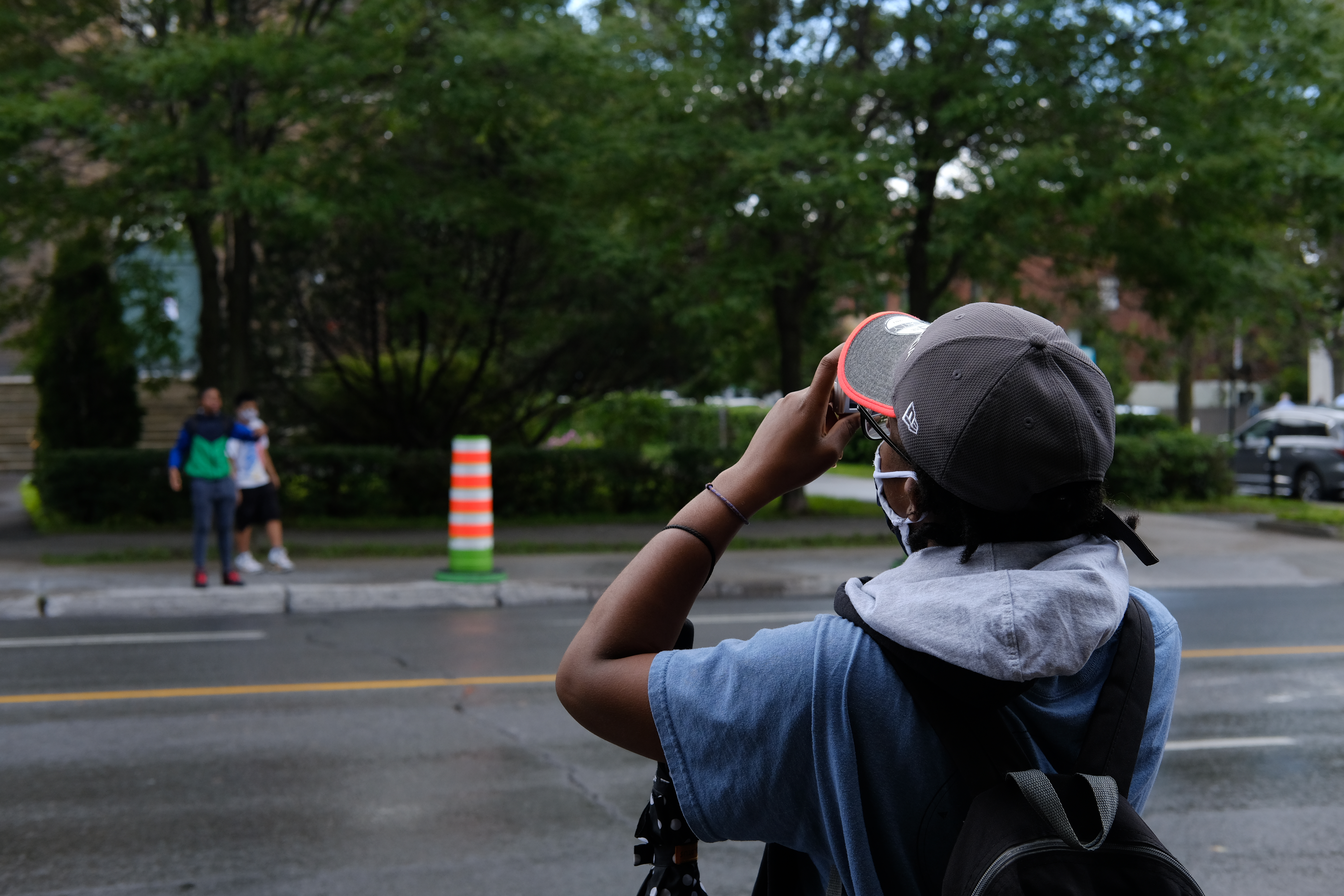
En commençant à marcher, une cinquième jeune s’ajoute au groupe et Anne-Marie lui prête son appareil photo. On se dirige vers la bibliothèque avant d’entrer dans la Plaza et sur le chemin, deux autres jeunes nous croisent et traversent la rue pour nous rejoindre. Ils se mettent en équipe de deux pour prendre des photos avec le cinquième appareil.
Marc, qui était le plus gêné au début, me pose maintenant plein des questions sur comment réaliser par exemple une composition avec des diagonales et je lui explique un peu plus en référant les lignes, l’architecture et les fenêtres du bâtiment de la bibliothèque. Je lui propose aussi d’essayer la composition en espaces négatifs, en laissant du vide afin de laisser respirer son image. Il tente le coup en cadrant les feux de circulation tout en laissant du vide (le ciel) autour. Il est vraiment investi dans la démarche et me demande souvent mon avis sur ses photos.
Après quelques prises de vue sur le Chemin de la Côte-des-Neiges, nous décidons d’entrer dans la Plaza. En plus de déjà ressembler à un centre commercial de film de zombies, tout est en construction, ce qui ajoute au caractère d’étrangeté.
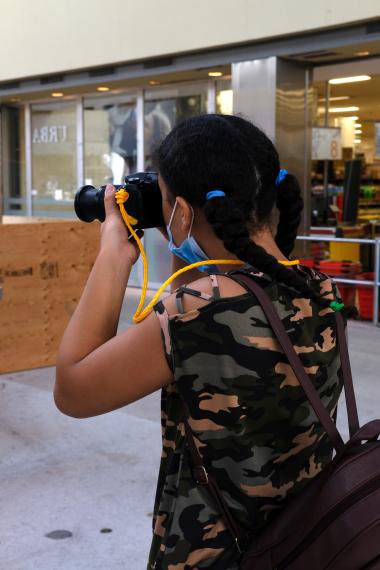
Durant l’atelier, un petit trio se forme et trois des filles se suivent partout. Elles entrent dans un magasin de vêtements où tout est très coloré et elles y restent un bon moment.
On continue notre chemin et les jeunes s’éparpillent un peu, tous.tes interpellés par des éléments distincts. Certain.es vont prendre des photos du plafond vitré, d’autres de l’escalier mobile, des drôles de lampadaires, ou encore de toutes sortes de bidules se trouvant dans les vitrines des magasins.
La batterie de l’appareil de Mélodie* se vide, mais heureusement Ducakis était allé acheter des caméras jetables à la pharmacie. Jasmine* décide elle aussi de continuer avec la caméra jetable, mais attention, elles n’ont que 27 prises! Je leur conseille donc de bien réfléchir à ce qu’elles décident de capter et de prendre plus leur temps pour se positionner qu’avec une caméra digitale.
Après avoir fait le tour, on sort de l’autre côté du centre pour arriver dans le stationnement, qui est pratiquement vide et on s’amuse tous.tes à le photographier de différents angles. Avant même de sortir du stationnement, Mélodie avait déjà utilisé toutes ses prises!
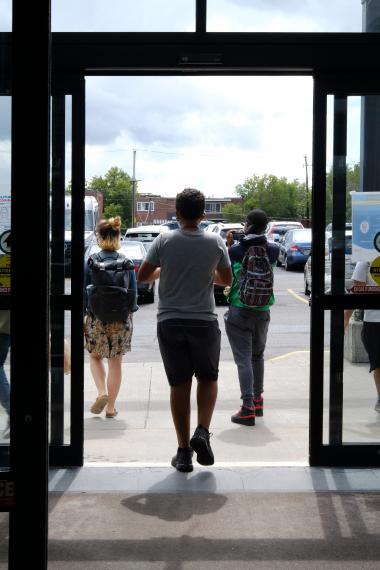
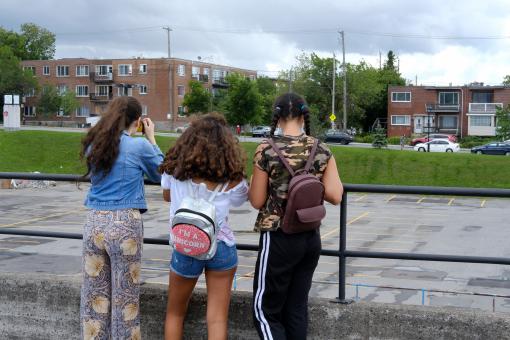
On continue le circuit sur la rue Légaré pour rencontrer plusieurs autres sujets qui piquent l’attention des jeunes, comme des graffitis et un peu plus loin, des plantes et des abeilles qui bourdonnent. Je reste un moment avec elles et les abeilles pendant que l’autre moitié du groupe marche plus loin devant nous, tournant à droite sur l’Avenue de Courtai.
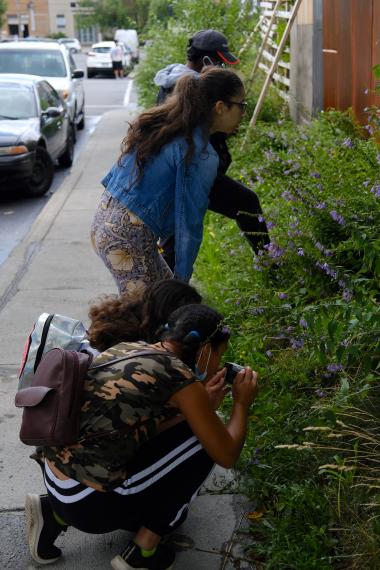
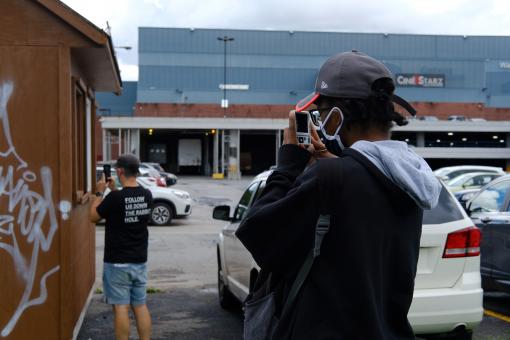
Dès que l’on tourne, on se retrouve immédiatement dans un coin plus industriel, rempli de garages, de machines, de vieux pneus… C’est une toute autre scène et tout le monde est attiré à gauche et à droite par différents détails.

L’une des jeunes, Natacha*, est plus solitaire et tranquille, mais je la trouve tout autant investie et intéressée que les autres, n’hésitant pas à se déplacer partout et à se laisser porter par ce qui attire son attention.

Passé ce voisinage plus industriel, nous arrivons devant la société bouddhiste Quan-Am et des bâtiments en construction. Marc s'exclame ah je ne savais pas qu’il y avait un temple ici! et il place son objectif entre les barreaux de la porte pour pouvoir photographier les lieux.
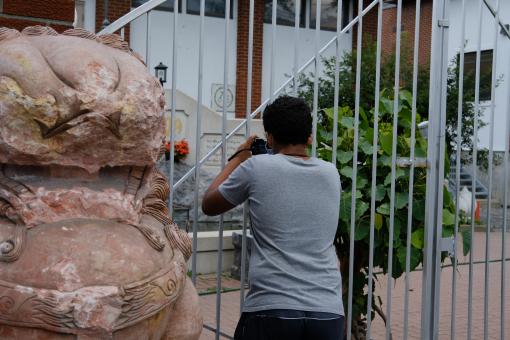
Un peu plus loin sur la même rue, nous croisons une bâtisse un peu vieille, toute bleue, remplie de graffitis, où il est signé MDJ CDN (Maison des jeunes Côte-des-Neiges). On s'arrête pour la prendre en photo. Marc vient vers moi et me demande comment je trouve sa photo: on y voit un graffiti d’un homme en noir et blanc, qui semble prier, avec des rayons tout autour de lui. Je lui réponds que c’est un bon choix dans ce cas-ci d’avoir choisi de faire une composition centrée! Il semble satisfait et continue de marcher.

Au bout de la rue, nous arrivons devant un grand mur qui cache le boulevard et puis de l’autre côté, en face de ce mur, un bloc d’appartements recouvert lui aussi de graffitis. Certain.es le photographient du travers de la rue, d’autres se rapprochent des fenêtres et Thierry et Anne-Marie placent leur caméra entre les trous du mur pour capturer le boulevard de l’autre côté.

En revenant vers le parc, nous croisons d’autres éléments intéressants que j’ai pu remarquer, comme une bâtisse en construction couverte de mousse jaune, une vieille affiche de commerce... Sur le trottoir, une fruiterie présentent des bananes, des oranges, des oignons, etc. et Marc s’arrêtent pour les photographier; je fait de même, trouvant que c’est une belle observation de sa part.
À la fin du circuit, nous leur réservons une surprise: on termine ça autour d’une crème glacée que nous mangeons sur les bancs du parc! Nous revenons ensuite sur l’atelier, pour savoir ce qu’ils ont aimé et ce qu’ils ont découvert de leur quartier. Natacha dit réaliser qu’elle connaît en fait très bien son quartier. D’autres ont découvert par exemple le temple bouddhiste, ou encore les graffitis sur cette rue. Personnellement, j’ai beaucoup aimé aller dans la Plaza et dans le coin plus industriel. Nous avons constaté aussi que nous n’étions pas nécessairement allés aux endroits énumérés au début, car nous nous sommes plutôt laissé emporter par le moment, par ce que nous avions tout simplement envie de photographier.
Andréanne leur demande ensuite qui s’est découvert une passion pour la photo? et Marc et Mélodie lèvent la main, avec le sourire. Vers la fin du circuit, Marc a d’ailleurs dit à Thierry «J’espère qu’après l’atelier, je vais pouvoir devenir photographe professionnel.»
Pour terminer, nous avons réfléchis avec les jeunes sur l’atelier. Je leur fais remarquer que la photo nous force à regarder d’un oeil différent notre quartier et tout ce qui nous entoure. Plusieurs acquiescent. Je pense que la photo nous permet aussi de voir la beauté dans tout; en observant on la découvre partout. Nous cherchons aussi à savoir ce qui intéresserait les jeunes pour la suite de l’atelier. Allons-nous faire un séance de sélection de nos meilleures photos? Créer une exposition ou peut-être recueillir toutes les photos sous forme d’un livre? Plusieurs semblent aimer l’idée du livre. À la prochaine sortie photo en tout cas, ça se passera en famille!
*Tous les noms sont fictifs et ont été changés afin de conserver l'anonymat des participant.es.
ENGLISH
On Wednesday August 5, I was invited to join a photo workshop in Côte-des-Neiges with Ducakis and Thierry, two of our mediators. The project was initiated by Ducakis a year ago and the goal is to introduce photography to participants and allow them to (re)appropriate their neighborhood through this artistic medium.
Photography is one of my favorite mediums. I've been doing a lot of photography since I was 15 and developed my practice during my bachelor's degree in visual arts, so I was really excited to be able to share one of my passions with teenagers.
Baobab familial is an organization that promotes mutual aid, exchange and the feeling of belonging to its environment by welcoming and supporting families in their daily lives. I'm also hearing the audience will be teenagers, but we don't know how many will participate today. Not knowing their level of knowledge on photography either, I prepared a memory sheet for them showing some examples of compositions, framing and angles of view.
Before leaving with the van, I print four copies of the cheat sheet, because we eventually learn that there will probably be four to participate. We put together five cameras, make sure they all have memory cards and full batteries and we disinfect them in the van on the way, towards Martin Luther-King Park.
At the park, we find the Baobab social workers, Anne-Marie and Andréanne, at a picnic table and we introduce ourselves. They tell us that they will eventually be more numerous, that more will arrive later, and we tell ourselves that they can team up in pairs or use their cellphones to take pictures if necessary.
When four of the participants arrive, Ducakis explains the workshop. One of them, Marc*, was standing further back and Thierry speaks to him, trying to get him to sit closer. We cover ourselves under a roof since it starts to rain intensely and after my quick lesson on the compositions, the rain stops. We then distribute the cameras and spend a few minutes seeing the technical functioning of the devices, as they are all different. I also let them know that in photography, you shouldn't be afraid to move around, to point your lens up, down, to the side, etc. Photography is sport!
Before starting the journey, we ask everyone what they would like to take a picture of, what they like and dislike in their neighborhood and to name places of their daily life, for example, in order to determine which route we are going to take. Marc talks about the sports center and the convenience store at the corner of his street, someone mentions the library and the park, another the Tim Hortons and Thierry would like to go take pictures in the Plaza (because if he had to shoot a zombie movie, it would be his place of choice).
As we begin to walk, a fifth person joins the group and Anne-Marie lends her her camera. We walk towards the library before entering the Plaza and on the way, two other participants see us and cross the street to join us. They team up in pairs to take pictures with the fifth camera.

Marc, who was the most shy at the beginning, now asks me lots of questions about how to make a composition with diagonals, for example, and I explain a little more to him by referring to the lines, the architecture and the windows of the library building. I also suggest that he tries the composition in negative spaces, leaving room to breathe in the image. He tries it by framing the traffic lights while leaving negative space (the sky) around. He is really invested in the process and often asks me my opinion on his photos.
After a few shots on the Chemin de la Côte-des-Neiges, we decide to enter the Plaza. Besides already looking like a zombie movie mall, everything is under construction, which adds to the eeriness.
During the workshop, a trio is forming and three of the girls follow each other everywhere. They walk into a clothing store where everything is very colorful and they stay there for a while.
We continue our walk and the participants are scattered a bit, each of them attracted by different things. Some will take pictures of the glass ceiling, others of the mechanical stairs, the funny lampposts, or even all kinds of gadgets in store displays.
The battery of Mélodie's* camera is empty, but luckily Ducakis had bought disposable cameras at the pharmacy. Jasmine* also decides to continue with the disposable camera, but be careful, they only have 27 takes! I therefore advise them to think carefully about what they decide to capture and to take more time to position themselves than with a digital camera.
After going around, we exit on the other side of the center into the parking lot, which is practically empty and we all have fun photographing it from different angles. Before even leaving the parking lot, Mélodie had already used all of her shots!

We continue the circuit on Légaré Street to meet several other subjects that grab the attention of the teens, such as graffitis and, a little further, plants and buzzing bees. I stay with them and the bees for a little while the other half of the group walks further ahead, turning right onto Courtai Avenue.
As soon as we turn, we immediately find ourselves in a more industrial sector, filled with garages, machines, old tires... It's a whole different scene and everyone is drawn left and right by different details.
One of the participants, Natacha*, is more solitary and quiet, but I find her just as invested and interested as the others, not hesitating to move around and let herself be carried away by what catches her attention.

After this more industrial neighborhood, we come to the Quan-Am Buddhist society and buildings under construction. Marc exclaims ah I didn't know there was a temple here! and he places his lens between the fence to be able to photograph the entrance.
A little further on the same street, we come across an older building, all blue, filled with graffiti, where it is signed MDJ CDN (Maison des jeunes Côte-des-Neiges). We stop to take pictures and Marc comes up to me and asks me how I find his photo: it shows graffiti of a man in black and white, who seems to be praying, with rays all around him. I tell him that it is a good choice in this case to have chosen a centered composition!

At the end of the street, we come to a large wall that hides the boulevard and then in front of this wall, an apartment block also covered in graffiti. Some photograph it from across the street, others move closer to the windows and Thierry and Anne-Marie place their cameras between the holes of the wall to capture the boulevard on the other side.

Coming back to the park, we come across other interesting elements that I noticed, such as a building under construction covered with yellow moss, an old commercial poster... On the sidewalk, a fruit store presents bananas, oranges, onions, etc. and Marc stops to photograph them; I do the same, thinking it is a nice observation from him.
At the end of the walk, we have a surprise in store for them: it ends with an ice cream that we eat on the park benches! We talk about the workshop to find out what they liked and what they discovered about their neighborhood. Natacha says she realizes that she actually knows her neighborhood very well. Others have discovered the Buddhist temple, for example, or the graffitis on this street. Personally, I really enjoyed going to the Plaza and to the industrial area. We also found that we did not necessarily go to the places listed at the beginning, because we rather let ourselves be carried away by the moment, by what we just wanted to photograph.
Andréanne then asks them who discovered a passion for photography? and Marc and Mélodie raise their hands, with a smile. Besides, towards the end of the tour, Marc said to Thierry, "I hope that after the workshop, I can become a professional photographer."
Finally, we reflected on the workshop with the participants. I point out to them that photography forces us to look at our neighborhood and at everything around us differently. Several of them nod in agreement. I think photography also allows us to see the beauty in everything; by looking we find it everywhere. We are also trying to find out what would interest them for the rest of the workshop. Are we going to do a selection of our best photos? Create an exhibit or maybe collect all the photos to form a book? Many seem to like the idea of the book. At the next photo workshop anyway, it will be with the entire family!
*Names are all fictional and have been changed to keep anonymity of the participants.



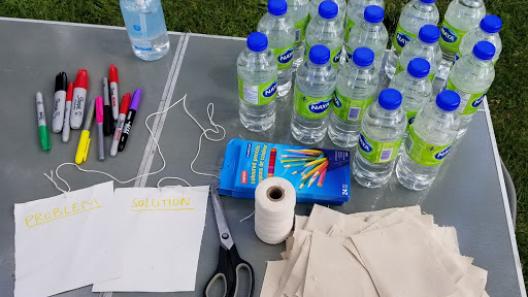


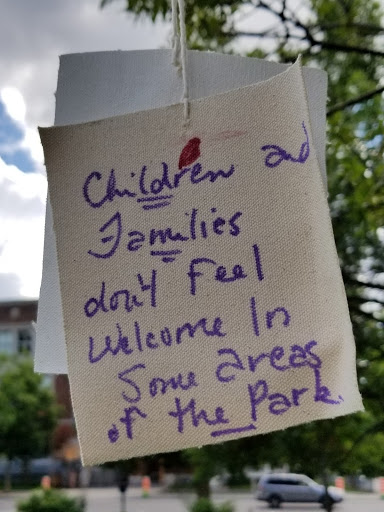
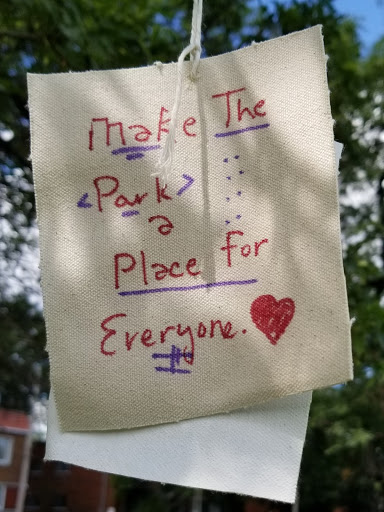
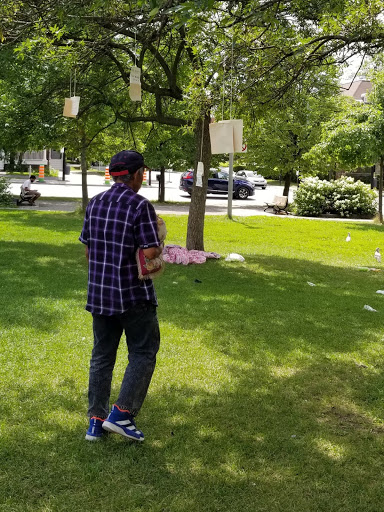
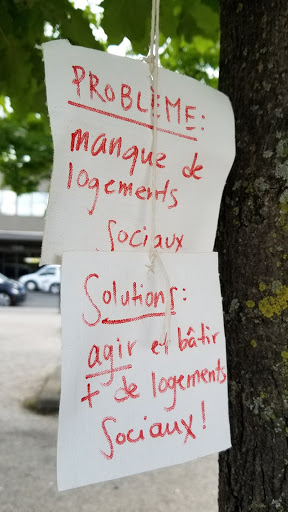

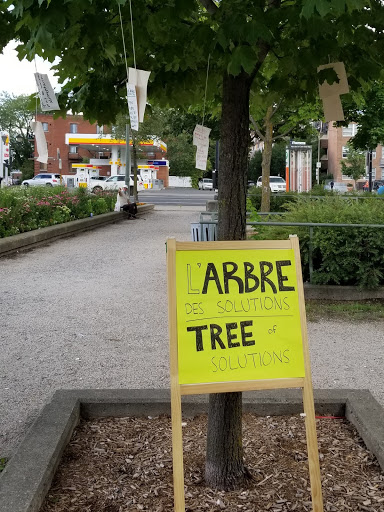






 Laurier
Laurier